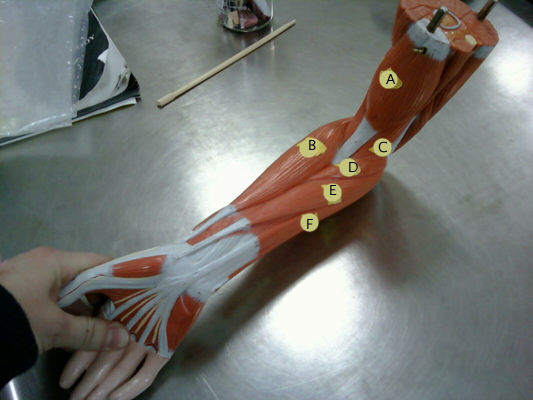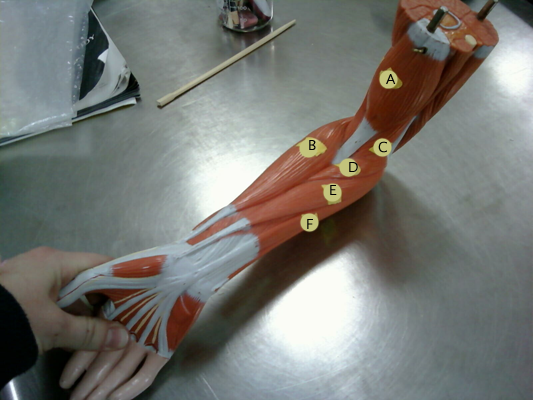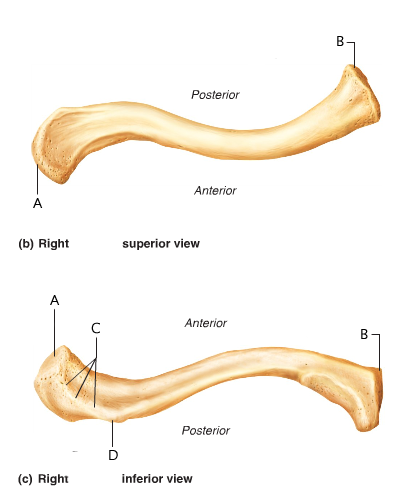Anatomy And Physiology 141 Lab Practical 2

Practice for Lab practical 2. Bio 141 A&P. Uses drawings and photographs of models. ALL answers must be spelled correctly for credit. Bones, joints, muscles. Yes, it's a very long practical, but it covers a good majority of what is expected.
- 1.
Name muscle A
Explanation
The correct answer is "biceps brachii." The biceps brachii is a muscle located in the upper arm. It is a two-headed muscle that runs from the shoulder to the elbow. The word "biceps" refers to the fact that this muscle has two heads, and "brachii" indicates its location in the arm. The biceps brachii is responsible for flexing the elbow joint and rotating the forearm.Rate this question:
- 2.
Name muscle E
Explanation
The muscle E is named flexor carpi radialis.Rate this question:
- 3.
Name muscle B
Explanation
The correct answer for the given question is "brachioradialis." The brachioradialis muscle is located in the forearm and plays a role in flexing the forearm at the elbow joint. It is a long muscle that runs along the radial side of the forearm, connecting the upper arm bone to the radius bone in the forearm. The name "brachioradialis" is derived from its location, as it is situated between the brachialis muscle and the radius bone.Rate this question:
- 4.
Name muscle C
Explanation
The correct answer is "brachialis" because it is the name of the muscle being referred to in the question. The brachialis muscle is located in the upper arm and is responsible for flexing the elbow joint.Rate this question:
- 5.
Name muscle D
Explanation
The muscle named "pronator teres" is referred to as muscle D.Rate this question:
- 6.
Name muscle F
Explanation
The muscle F is called palmaris longus.Rate this question:
- 7.
Name muscle A
Explanation
The muscle A is named flexor carpi ulnaris.Rate this question:
- 8.
Name muscle B
Explanation
The correct answer is extensor carpi ulnaris. This muscle is located in the forearm and is responsible for extending and adducting the wrist. It originates from the lateral epicondyle of the humerus and inserts into the base of the fifth metacarpal bone. Its main function is to extend the wrist, allowing for movements such as bending the hand backward and moving it towards the little finger side of the forearm.Rate this question:
- 9.
Name muscle C
Explanation
The muscle name "extensor digitorum" accurately describes its function and location. "Extensor" indicates that the muscle extends or straightens a body part, while "digitorum" refers to the digits or fingers. Therefore, the extensor digitorum muscle is responsible for extending the fingers, helping in actions such as opening the hand or gripping objects.Rate this question:
- 10.
Name this Bone
Explanation
The correct answer is clavicle. The clavicle, also known as the collarbone, is a long bone that is located in the upper chest region. It connects the sternum (breastbone) to the scapula (shoulder blade) and helps to support the shoulder and arm. The clavicle is easily identifiable due to its S-shape and is the only long bone in the body that lies horizontally.Rate this question:
- 11.
Name A
Explanation
The given answer includes two terms, "acromial end" and "acromial lateral end". These terms are likely referring to different portions or aspects of a structure called the acromion. The acromion is a bony process on the scapula (shoulder blade) that forms part of the shoulder joint. The "acromial end" may refer to the tip or outermost part of the acromion, while the "acromial lateral end" may refer to a specific lateral aspect or side of the acromion. Without further context, it is difficult to provide a more specific explanation.Rate this question:
- 12.
Name B
Explanation
The given answer suggests that the name "B" refers to two different parts of the sternum - the sternal end and the sternal medial end. The sternal end is the part of the sternum that connects to the clavicle, while the sternal medial end is the middle portion of the sternum. Therefore, "B" can be used to identify both of these specific areas on the sternum.Rate this question:
- 13.
Name B
Explanation
The correct answer is iliac fossa. The iliac fossa is a concave surface located on the inner surface of the ilium bone, which is one of the bones that make up the hip. It is a smooth, shallow depression that provides attachment for various muscles and ligaments. The iliac fossa is an important landmark in anatomy and is commonly used as a reference point in medical imaging and surgical procedures involving the hip region.Rate this question:
- 14.
Name C
Explanation
The correct answer is a list of synonyms for the same anatomical structure, which is the coxal bone or hip bone. The term "coxal" refers to the bones of the hip, specifically the two coxal bones that make up the pelvis. "Coxal bone" is another way to refer to the same structure. "Os coxae" is the Latin term for the hip bone, and "hip bone" is the common name used to describe this part of the skeleton.Rate this question:
- 15.
Name D
- 16.
Name F
- 17.
Name G
- 18.
Name H
- 19.
Name I
Explanation
The correct answer is "pubic tubercle" because the question asks for the name of a specific anatomical structure, and "pubic tubercle" is the correct name for that structure.Rate this question:
- 20.
Name J
- 21.
Name K
Explanation
The correct answer is "pelvic brim." The pelvic brim refers to the boundary between the true pelvis and the false pelvis. It is also known as the pelvic inlet and is formed by the sacral promontory, the arcuate line of the ilium, and the upper border of the pubic symphysis. This anatomical landmark is important in obstetrics and gynecology as it helps determine the size and shape of the pelvic cavity, which can affect childbirth.Rate this question:
- 22.
Name L
Explanation
The given answer, "anterior inferior iliac spine," accurately identifies the name of the anatomical structure being described. The anterior inferior iliac spine is a bony projection located on the front and lower part of the ilium bone in the pelvis. It serves as an attachment point for various muscles and ligaments, playing a role in the stability and movement of the hip joint.Rate this question:
- 23.
Name M
Explanation
The sacral promontory is a bony prominence located at the anterior aspect of the sacrum. It is an important landmark in the pelvic region and serves as a reference point for various anatomical measurements and surgical procedures. The sacral promontory can be palpated during a physical examination and is commonly used in obstetrics to determine the level of the fetal head during labor.Rate this question:
- 24.
Name N
Explanation
The correct answer is "anterior superior iliac spine." The anterior superior iliac spine is a bony projection located at the front and top of the hip bone. It serves as an attachment point for various muscles and ligaments in the hip and thigh region. This structure can be easily palpated and is commonly used as a reference point for anatomical landmarks and measurements in clinical and research settings.Rate this question:
- 25.
Name O
Explanation
The iliac crest is the curved ridge at the top of the hip bone. It is the most prominent part of the ilium and serves as an attachment point for various muscles and ligaments. The iliac crest is easily palpable and can be used as a landmark for identifying anatomical structures and for performing certain medical procedures.Rate this question:
- 26.
Name this bone
Explanation
The bone being referred to in this question is called the atlas. The atlas is the first cervical vertebra in the spine, located at the top of the neck. It is responsible for supporting the skull and allowing for the nodding motion of the head. The atlas is named after the Greek mythological figure Atlas, who was said to carry the weight of the world on his shoulders.Rate this question:
- 27.
Name A
Explanation
The term "posterior tubercle" refers to a specific anatomical structure named "posterior tubercle". This structure is likely a part of a larger anatomical system or body part, but without further context or information, it is not possible to provide a more specific explanation.Rate this question:
- 28.
Name B
- 29.
Name C
Explanation
The correct answer is "transverse foramen." The transverse foramen is a structure found in the cervical vertebrae of mammals, including humans. It is a hole that runs horizontally through the transverse process of each cervical vertebra. The transverse foramen serves as a passageway for the vertebral artery and vein, which supply blood to the brain. This structure is important for maintaining proper blood flow and function in the neck and head region.Rate this question:
- 30.
Name D
- 31.
Name E
- 32.
Name F
Explanation
The given correct answer "anterior tubercle" is most likely referring to a specific anatomical structure. However, without any additional context or information about the question, it is not possible to provide a specific explanation for why this answer is correct.Rate this question:
- 33.
Name G
- 34.
Name this bone
Explanation
The bone being referred to in this question is the atlas. The atlas is the first cervical vertebra in the spine, located at the top of the neck. It is named after the mythical Greek Titan Atlas, who was said to bear the weight of the world on his shoulders. The atlas bone is responsible for supporting the skull and allowing for the nodding motion of the head.Rate this question:
- 35.
Name E
Explanation
The given answer, "inferior articular facet," is the correct answer because it accurately identifies the specific anatomical structure being referred to in the question. The term "inferior articular facet" typically refers to a feature found in joints, particularly in the vertebrae of the spine. This facet is a small, smooth surface that articulates with another structure, allowing for movement and flexibility in the joint.Rate this question:
- 36.
Name A
Explanation
The correct answer is "transverse process." The transverse process is a small bony projection that extends laterally from the vertebrae. It serves as an attachment point for muscles and ligaments, providing stability and support to the spine. Each vertebra has two transverse processes, one on each side, which help to protect the spinal cord and nerves. These processes also play a role in the movement and flexibility of the spine.Rate this question:
- 37.
Name this bone
Explanation
The bone being referred to in this question is the axis.Rate this question:
- 38.
Name A
Explanation
The correct answer is "dens, odontoid process". The question seems to be asking for the name of a particular anatomical structure, which is commonly known as the "dens" or "odontoid process". The dens is a bony projection that extends from the second cervical vertebra (axis) and plays a crucial role in stabilizing the neck and allowing for rotational movement of the head.Rate this question:
- 39.
Name D
Explanation
The answer is "spinous process" because it is mentioned in the given information. The question is incomplete and does not provide any context or specific details to further explain the answer.Rate this question:
- 40.
Name B
Explanation
The correct answer is "transverse process." The transverse process is a bony projection that extends from the side of a vertebra. It serves as an attachment point for muscles and ligaments, providing stability and support to the spine.Rate this question:
- 41.
Name C
Explanation
The correct answer is "inferior articular process." The inferior articular process is a bony projection found on the vertebrae of the spine. It articulates with the superior articular process of the vertebra below it, forming a joint that allows for movement and flexibility in the spine. This process plays a crucial role in the overall function and structure of the spine, allowing for smooth and coordinated movement between adjacent vertebrae.Rate this question:
- 42.
Name this type of vertebrae
Explanation
The correct answer is "cervical" or "cervical vertebrae." These terms refer to a specific type of vertebrae found in the neck region of the spine. The cervical vertebrae are responsible for supporting the head and allowing for a wide range of movement, such as tilting and turning the head. There are typically seven cervical vertebrae in the human body.Rate this question:
- 43.
Name A
Explanation
The correct answer is "spinous process." The spinous process is a bony projection that extends off the posterior (back) of each vertebra in the spine. It can be felt as a small bump or ridge along the midline of the back. The spinous process serves as an attachment point for muscles and ligaments, providing stability and support to the spine. It also helps protect the spinal cord and nerves that pass through the spinal column.Rate this question:
- 44.
Name B
Explanation
The given answer "superior articular process" is most likely the correct answer because it is mentioned after the name "B". It can be inferred that the question is asking for the name of a structure or process, and "superior articular process" is a plausible answer in this context.Rate this question:
- 45.
Name C
- 46.
Name D
- 47.
Name E (_______ and _______)
Explanation
The correct answer is "inferior articular process and facet, facet and inferior articular process." This answer suggests that both the inferior articular process and the facet are components of the structure named E. It implies that the two terms can be used interchangeably to describe the same structure.Rate this question:
- 48.
Name this type of vertebrae
Explanation
The correct answer is "thoracic" or "thoracic vertebrae." The term "thoracic" refers to the region of the spine that is located in the upper back, between the cervical (neck) and lumbar (lower back) regions. The thoracic vertebrae are the individual bones that make up this region of the spine. They are characterized by their attachment to the ribs, which provide support and protection for the organs in the chest.Rate this question:
- 49.
Name A
Explanation
The term "spinous process" refers to a bony projection that extends from the vertebrae in the spine. It is a prominent feature that can be felt along the midline of the back. The spinous process serves as an attachment point for muscles and ligaments, providing stability and support to the spine. It also helps to protect the spinal cord and nerves. Therefore, "spinous process" is the correct answer in relation to the given information.Rate this question:
- 50.
Name B
Explanation
The correct answer is "transverse costal facet." The transverse costal facet refers to a small articulating surface found on the transverse process of a thoracic vertebra. This facet allows for the connection and movement of the rib to the vertebra, contributing to the stability and flexibility of the thoracic spine.Rate this question:
Quiz Review Timeline +
Our quizzes are rigorously reviewed, monitored and continuously updated by our expert board to maintain accuracy, relevance, and timeliness.
-
Current Version
-
Aug 22, 2023Quiz Edited by
ProProfs Editorial Team -
Nov 01, 2009Quiz Created by
Amyrlin026
 Back to top
Back to top




















